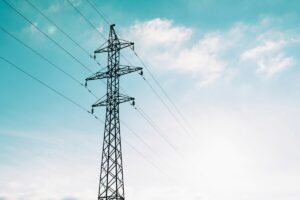The Fifth National Climate Assessment recently concluded that, to meet national and international climate targets, United States net greenhouse gas emissions will need to decline by over 6% per year and reach net zero by roughly 2050. In order to achieve this target, the United States will need to greatly expand electricity generation while decarbonizing electricity resources. In other words, the United States will need to build significant amounts of renewable energy infrastructure.

Because renewable energy resources like high-quality wind and solar energy are not equally distributed across the county, interregional transmission infrastructure is necessary to transport such energy to major population centers. The U.S. Department of Energy has stated that, in order to meet growing clean electricity demands, the United States must expand its transmission systems by 60% by 2030 and upwards of 300% by 2050.
One obstacle to meeting these targets is the ability of states to block interstate transmission projects. Under the Federal Power Act (FPA), the Federal Energy Regulatory Commission (FERC) has authority to regulate “the transmission of electric energy in interstate commerce.” This includes authority over regional transmission planning. States, however, retain primary authority over “siting, permitting, and construction” of most transmission lines.
States’ authority over transmission siting can serve as a substantial roadblock to the buildout of transmission lines. But a Middle District of Pennsylvania court recently established one key limit on states’ authority to block new transmission lines through the siting process. In an opinion that is currently under appeal in the Third Circuit, the Middle District court held that, because the federal government has authority to determine transmission system needs and potential solutions, a state cannot deny a siting permit based on its own determination that a project is not needed. States can still deny a siting permit based on concerns such as environmental and aesthetic impacts, but the court clarified that only the federal government can determine whether an interstate transmission project meets a public need. This is significant because it prevents states from vetoing a project on the basis that it only provides benefits to other states.
The Regulatory Structure for Electricity Transmission
Authority for interstate transmission planning and siting is divided between federal and state authorities. FERC Order No. 1000 clarifies that the federal government has authority over regional transmission planning and cost allocation, including “the processes used to identify and evaluate transmission system needs and potential solutions to those needs,” whereas states have authority over “siting, permitting, and construction” of most transmission lines.
In many parts of the country, transmission planning is undertaken by FERC-regulated bodies called regional transmission organizations (RTOs) and independent system operators (ISOs). PJM Interconnection is one such RTO, which oversees a region encompassing thirteen states, including Pennsylvania, along with the District of Columbia.
One of the responsibilities of RTOs such as PJM is to encourage market-driven actions for preventing and relieving grid congestion. Grid congestion occurs when transmission limitations prevent the least-costly resources from meeting demand in a given region. FERC has authorized RTOs to address such congestion by “planning, and [] directing or arranging, necessary transmission expansions, additions, and upgrades and coordinat[ing] such efforts with the appropriate state authorities.”
Transource Pa. LLC v. Defrank
The U.S. District Court for the Middle District of Pennsylvania issued a decision on December 6, 2023 in Transource Pa. LLC v. Defrank that limited state authority to deny transmission projects that RTOs had determined were needed based on federally-approved standards. PJM Interconnection had identified grid congestion across the Pennsylvania-Maryland border and concluded that such congestion had led to approximately $800 million in costs from 2012 to 2016. PJM determined that a project proposed by Transource consisting of new transmission lines running from West Virginia to Maryland would reduce this congestion and provide net positive economic benefits. PJM therefore concluded that there was a public need for the project, based on FERC-approved methods for determining public need. PJM also concluded that the project would economically benefit regions hurt by the congestion, while increasing costs for certain regions that were benefitting from the congestion. PJM approved the project in 2016 and entered into an agreement with Transource’s parent company allocating responsibilities for the project. FERC approved this agreement in 2017, and Transource then filed siting applications with the Pennsylvania Public Utility Commission (PUC), as required by Pennsylvania law.
Pennsylvania requires that utilities meet four requirements in order to receive PUC siting approval: (1) there is a need for the project; (2) the project will not create an unreasonable risk of danger to the health and safety of the public; (3) the project will comply with Pennsylvania’s natural resources laws; and (4) the project will have a minimum adverse environmental impact. In 2020, the PUC Administrative Law Judge (ALJ) denied Transource’s permit application on the basis that the project would increase wholesale rates in Pennsylvania and therefore failed to serve a public need under Pennsylvania law, despite providing benefits elsewhere within PJM’s territory. The PUC adopted and incorporated the ALJ decision in May 2021.
Transource then filed a complaint in the U.S. District Court for the Middle District of Pennsylvania. At issue in the case was whether the PUC’s determination that the project failed to meet a public need (1) violated the Supremacy Clause of the United States Constitution, and (2) violated the dormant Commerce Clause of the United States Constitution. The court held that the PUC’s decision violated both clauses.
The Supremacy Clause serves to “invalidate[] state law that interferes with or is contrary to federal law.” One of the ways in which federal law can preempt state law under the Supremacy Clause is through conflict preemption, which arises when: (1) state and federal laws directly conflict; or (2) “state law stands as an obstacle to the accomplishment and execution of the full purposes and objectives of Congress.” The court held that the PUC’s order was subject to conflict preemption in the second way described above because it created an obstacle to achieving federal objectives. In the words of the court:
It is clear that FERC has determined that regional congestion is a problem and one that directly affects its core obligation of ensuring just and reasonable electric rates. As such, it is not within the PUC’s purview to pose obstacles to FERC’s pursuit of reducing congestion through its approval process. Nor is it within the PUC’s authority to pose obstacles to this federal objective when PJM pursues it under the auspices of a FERC-approved tariff.
The court did not make a determination as to whether the PUC’s order was also conflict preempted under the separate justification of directly conflicting with federal law, citing a lack of controlling precedent.
Crucial to the court’s holding was its determination that the PUC’s order was not a valid exercise of its siting authority. All parties agreed that the PUC could have denied the application based on traditional siting concerns, such as concerns about site-specific environmental, public health, and aesthetic impacts. But the PUC was not allowed to “use these factors as a pretext for denying permission because it disagrees as to whether congestion needs to be relieved.” The court held that, “[a]lthough the PUC now terms its denial as an exercise of siting authority, it was regional transmission planning in reality.”
The court separately held that the decision also violated the dormant Commerce Clause, which “prohibits the states from imposing restrictions that benefit in-state economic interests at out-of-state interests’ expense.” The court held that “the PUC’s decision was a per se violation of the dormant Commerce Clause driven by economic protectionism.” Transource’s project was designed to “facilitate commerce across regional and state boundaries,” and the PUC’s order was “focused on protecting the interests of Pennsylvanians . . . in the form of maintaining the status quo imbalance of access to low-priced electricity.” The court therefore struck down the PUC’s decision on both conflict preemption and dormant Commerce Clause grounds.
On January 10, 2024, the Pennsylvania PUC and other Defendants filed a notice of appeal to the Court of Appeals for the Third Circuit, where the case is currently pending.
Implications of the Decision
If upheld on appeal, the Middle District decision will be significant for preventing states from vetoing transmission projects with solely out-of-state benefits. The court noted that, “if other states adopted a regime similar to the PUC . . . [they] could effectively deploy a veto as to whether regional transmission projects were desirable as congestion-reducing projects.” The court’s conclusion aligns with the analysis of various experts in the field. For instance, in its 2013 report on Policies for a Modern and Reliable U.S. Electric Grid, the Bipartisan Policy Center argued that:
[I]ndividual state authorities may be bound by state statutes to accept or reject the project on the basis of their in-state transmission needs, or the in-state benefits that the project offers. In these cases, states may not be empowered to consider the regional benefits of a proposed project. In some states, regulators might even be required by law to reject a project that does not serve load within the state’s boundaries, even in cases where the project delivers broader benefits to the region at large that the state would share in over time.
Alexandra Klass echoed the Bipartisan Policy Center’s concerns in her 2017 article on Expanding the U.S. Electric Transmission and Distribution Grid to Meet Deep Decarbonization Goals, further noting that “the fact that states are primarily responsible for siting and eminent domain for interstate transmission lines often severely limits the ability of utilities, merchant transmission lines, and others to obtain approval to construct lines needed to integrate new electricity generation into the grid to meet deep decarbonization goals.”
Despite this widespread recognition of the potential for states to veto transmission projects based on lack of in-state benefits, the Pennsylvania PUC appears to be among the first state agencies to explicitly base a permit denial on disagreements as to the need for a transmission project. In its briefing, Transource had “point[ed] out that it [was] unaware of any instance in which a state has directly disregarded FERC-approved regional planning methodology in the same way as the PUC.” If upheld on appeal, the Transource court’s holding would signal that the Pennsylvania PUC’s approach could not spread to other states, potentially deterring states from vetoing a project that would provide solely out-of-state benefits. Given the increasing need for transmission between different regions of the United States to achieve electricity-sector decarbonization, this holding could remove one significant barrier to national decarbonization goals. However, even if upheld and widely adopted, the Transource holding would not prevent states from vetoing projects based on traditional siting considerations such as local environmental concerns.
Jacob Elkin is a Renewable Energy Legal Defense Initiative Fellow at the Sabin Center.



